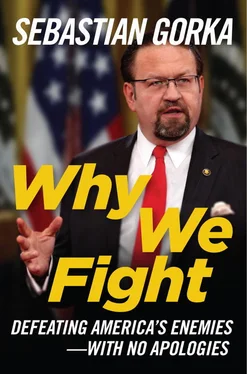THE JIHADISTS FIND THEIR MAO
Prior to the success of the Islamic State, the key strategists of the Global Jihadist Movement were less than pragmatic. The majority saw violence as a sacred act with the fate of their movement wholly contingent on the will of Allah. The holy warriors of Allah would execute violence against the infidel in an escalation of operations until the caliphate was miraculously established.
This idealistic attitude was challenged in 2004 when the Egyptian Abu Bakr Naji published The Management of Savagery on the internet. Although Naji was killed not long afterwards, he provided the Jihadist Movement with a much deeper understanding of irregular warfare than it had before. The Management of Savagery is a very dangerous book.
Like all jihadis, Naji believed that a Muslim must live under a caliphate and that war must be waged until the Empire of Islam covers the world. He makes it clear, however, that violence alone will not produce a functioning caliphate. Instead, the jihadi movement must follow a comprehensive plan of operations that will bring about the desired theocracy in stages. Naji describes three operational phases.
Phase One is vexation . In the initial stage, the jihadist organization will wage irregular warfare, executing dramatic terrorist attacks against the infidel and his regional partners. The goal here is to weaken the infidel and apostate partner governments and prepare the battle space for the next phase.
Phase Two is spreading savagery . The jihadist organization steps up its irregular warfare, drastically increasing the size and frequency of its attacks. The objective of Phase Two is to dislocate the local government, making it impossible for the Syrian government or the administration in Baghdad, for example, to exercise true sovereign control over its territory. The chaos becomes so bad that the population loses faith in the existing government and comes to accept the insurgents, vicious though they may be, as a preferable alternative.
Phase Three is administer savagery, consolidate, expand . Now, the insurgents consolidate their control of captured territory (“hold and build”). Members of the local population are integrated into new fighting units. A new governance structure is put in place, wedding the provision of services with imposition of a draconian system of justice based on sharia law. The captured territory is gradually converted into a new “base state” that can be used as a launching platform for Phase One and Phase Two operations in new territories—Libya and Yemen, for example—continuing the expansion of the caliphate.
The significance of Naji’s work is that it gave the global jihadi movement a measure of pragmatism and a real understanding of irregular warfare that had been missing for ideological and theological reasons. Phase Three is really a transitional stage, after which the final global caliphate will be achieved, a period when the jihadist enterprise is functioning as a quasi-nation-state with a fixed territory, administration, and monopoly of force. Earlier jihadi strategists had rejected the Westphalian nation-state as a heretical construct of the infidel West. Naji’s great contribution—and a very dangerous one—was to argue in The Management of Savagery that even if one doesn’t like the nation-state conceptually, it is an evolutionary stage through which the movement must pass if it is to serve Allah by re-establishing his Islamic Empire. And Naji’s pragmatic approach was effectively implemented by Abu Bakr and his Islamic State jihadists during President Obama’s second term, especially after his disastrous decision in 2011 to withdrawal our troops from Iraq.
Since President Trump assumed command, the United States and its local partners have been remarkably successful in taking the fight to the new Islamic State. But the war is far from over, and other jihadists may follow Naji’s strategy to destabilize other parts of the world important to America.
WAR BY OTHER MEANS: THE SOVIET UNION IS DEAD, LONG LIVE THE RUSSIAN FEDERATION
Today’s Russia may not be the Soviet Union. It is not an existential threat to the United States. But it is an anti-status quo actor and a spoiler controlled by a thuggish former KGB officer who called the dissolution of the USSR the “greatest geostrategic calamity of the twentieth century.” Moscow is therefore committed to re-establishing its unchallenged dominance in Central and Eastern Europe and beyond. Its invasion of the sovereign nation of Ukraine and the annexation of Crimea were masterly demonstrations of how to conduct irregular warfare in a post–Cold War and post-9/11 world. Its exploitation of the vacuum left by the withdrawal of American combat forces from Iraq in 2011 shows how ambitious the Kremlin is to reshape the geopolitics of the Middle East as well.
How has Russia done this? Some have argued that it has developed a new mode of “hybrid war.” This is not true. Moscow has simply further developed and recalibrated old Cold War tools, employing them in a way that emphasizes a less direct and more subversive approach to war that Sun Tzu would have instantly recognized.
Some of the most important work showing the world how Russia is winning its wars without recourse to conventional means is coming from the Baltic nations of Estonia, Latvia, and Lithuania, which are under the greatest threat since the invasion of Ukraine. The best English-language summary of the revamped Russian approach to war can be found in the 2014 report of the National Defense Academy of Latvia’s Center for Security and Strategic Research. Titled Russia’s New Generation Warfare in Ukraine: Implications for Latvian Defense Policy , it identifies eight ways the Russians are adapting their strategy for conflict in the twenty-first century:
• From direct destruction to direct influence. From direct conflict to “contactless war.”
• From direct annihilation of the enemy to subverting it internally.
• From war with kinetic weapons and an emphasis on technology and platforms to a “culture war” attacking the will of the enemy.
• From war built around conventional general-purpose forces to sub-conventional war using special forces and irregular groupings and militias.
• From the traditional three-dimensional perspective of the battle space to an emphasis on information operations, psychological operations, and the “war of perceptions.”
• From compartmentalized war to a “total war,” including the targeting of the enemy’s “psychological rear” and population base.
• From war focused on the physical environment to war targeting human consciousness, cyberspace, and the will of the enemy to fight.
• From war in a defined period to a state of “permanent war.” War as the nation’s natural state.
The Russians implemented these new strategies in Ukraine, which was subverted politically, psychologically, and economically before any hostilities broke out. The Latvian report describes eight clear phases in the subversion of Ukraine:
Phase One: Non-military unconventional warfare encompassing informational, moral, psychological, ideological, diplomatic, and economic measures supporting the overall Russian plan to establish a political, economic, and military environment favorable to the interests of Moscow.
Phase Two: Special operations designed to mislead the adversary’s political and military leaders, including the leaking of false information and counterfeit orders to diplomatic channels, the media, and key government and military agencies.
Phase Three: Subversion . Intimidating, deceiving, and bribing adversarial government personnel and military officers with the objective of making them abandon their official and service duties.
Читать дальше












